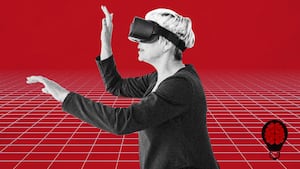In 2018, Kristin Hooker had been taking antidepressants for 20 years. She would try a new medication, which might work for a little while, but then her depression would return and she’d have to try something new.
Eventually, she ran out of new medications to try.
“I just wasn't finding a medication that really worked anymore,” the 39-year-old told The Daily Beast. “So, I became severely depressed, and I knew that I needed something else.”
After several unsuccessful alternative therapies, the Portland-based writer came across Transcranial Magnetic Stimulation (TMS). It’s a type of non-invasive brain stimulation that applies magnetic pulses to the head to activate neurons in the left dorsolateral prefrontal cortex, a brain region that is thought to be dysregulated in people who are depressed.
Hooker didn’t have especially high hopes for the treatment, but after learning that side effects are generally mild, she figured she might as well give it a try. (Mild headaches are a fairly commonly reported side effect, while more serious side effects, such as seizures, are very rare.)
Every weekday for eight weeks, she went to her TMS sessions, watching the Great British Bake Off while the electromagnetic coil stimulated her brain. “It's a little annoying,” she said, “but it just feels like tapping, it doesn't hurt at all.”
At first, Hooker didn’t notice anything different. But by the end of the eight weeks, she began to feel noticeably better and by the time she reached a few months after the start of treatment, her depression had evaporated.

Lucinda Smith, a former teacher who has struggled with depressive episodes since childhood, is treated with transcranial magnetic stimulation by UC Davis physician Dr. Gouhua Xia.
Florence Low/Getty“TMS has been kind of a lifesaver for me,” said Hooker. “When I was severely depressed, my main symptom was brain fog…. I just never felt present. I was daydreaming a lot. TMS brought me back to a place where I was like a fully functioning person again.”
TMS represents a different way of thinking about depression treatment, targeting specific brain regions rather than targeting neurotransmitters like serotonin or dopamine. Like any therapy, TMS isn’t perfect, but when other depression treatments have failed again and again, it may be the thing that finally gives patients some relief. And it hasn’t even reached its final form: A small but dedicated band of researchers are hard at work developing faster-acting and more effective versions.
Origin Story
The story of TMS begins in 1985, when researchers at the University of Sheffield in the U.K. published findings that magnetic stimulation of the motor cortex (the region of the brain that controls movement) could actually make a subject’s hand twitch. This showed that stimulation applied from outside the brain could have measurable effects on the brain itself, without inducing seizures like electroconvulsive therapy.
Years later, researchers at the National Institute of Mental Health in the U.S. noticed that a certain area of the brain (the left prefrontal cortex) seemed to be underactive in people who were depressed and wondered if they could use TMS to bring brain activity back to normal levels and alleviate patients’ symptoms. In 1995, they published the results of a small trial where six patients with highly treatment-resistant depression were treated with TMS. Two participants experienced dramatic improvements.
Over the following years, further studies showed that TMS was effective for at least some patients with depression, and the FDA approved TMS as a treatment for treatment-resistant depression in 2008.
There was just one catch: Even though the treatment was approved, it wasn’t covered by Medicare (and subsequently most other insurance companies) until 2014, according to Simon Kung, a psychiatrist at the Mayo Clinic Depression Center.
“When TMS first came out, it did make a big splash,” Kung told The Daily Beast. “However, between 2008 and 2014, patients might have heard about [TMS], but when it comes down to it, there was no way to pay for it. So, then I think enthusiasm decreased.”
Even today, TMS remains fairly uncommon. Neuronetics, which claims to be the largest TMS company, has treated approximately 130,000 patients—a tiny fraction compared to the millions of Americans that take antidepressants.
While antidepressants are helpful for many people, TMS can provide relief when medications fail: while results vary by trial, as many as 60 percent of patients experience substantial improvement in their depression symptoms. TMS is most commonly used for treatment-resistant depression, but it has also received FDA clearance for obsessive compulsive disorder and smoking cessation. Clinical trials are currently in progress for a variety of disorders, including schizophrenia and anorexia.
Waiting to Break Out
All this begs the question: if TMS works so well for hard-to-treat disorders, why isn’t it more common?
There are several reasons. Nolan Williams, director of the Stanford Brain Stimulation Lab, told the Daily Beast that for decades, psychiatrists have looked at treatments for mental health disorders through the lens of either psychotherapy or pharmacology—talk therapy or drugs. There has been a focus on brain biochemistry, such as how neurotransmitters like serotonin or norepinephrine should be altered to help treat certain disorders. In contrast, electrical activity—“the alternative currency of the brain,” according to Williams—has been relatively overlooked.
Getting psychiatrists to change perspectives and think in terms of electricity and brain circuits instead of (or at least in addition to) biochemistry, “is a huge ask,” said Williams. This shift doesn’t happen overnight, and physicians can be notoriously slow to accept new treatments.
Kung added that accessibility is also an issue: TMS requires daily treatment for several weeks, which can be prohibitive, especially for people living in more rural areas.

Research assistant Gabrielle Block simulates a TMS therapy session on John Elder Robison at Beth Israel Hospital in Boston.
Keith Bedford/Boston Globe via GettyAnd TMS isn’t a silver bullet for all cases of depression. Between 45 to 60 percent of patients will respond to TMS (clinically speaking, that means experience a 50 percent reduction in symptoms). And only 30 to 40 percent will see a total remission in symptoms (i.e. no longer be considered clinically depressed).
And there’s the question of how long this treatment actually provides relief. TMS doesn’t necessarily replace medication or psychotherapy, and the effects don’t last forever: for people who initially responded to treatment, slightly less than half had maintained this response one year later. However, subsequent rounds of TMS may also be effective—Hooker has been treated with TMS four times, with the benefits lasting between six months and more than a year after each treatment.
There are also some concerns about the placebo effect. While virtually all trials of TBS for treatment-resistant depression show that a meaningful percentage of people experience a reduction in symptoms, sometimes people receiving the sham (i.e. placebo) treatment do just as well. In one study of veterans with treatment-resistant depression, about 40 percent of patients who got TMS experienced remission; so did about 40 percent of the patients who got the fake treatment. Researchers noted that, “veterans’ expectations of improvement and extensive attention provided by the repetitive TMS treatment team may have played a large role in the significant clinical improvements they experienced.”
Further complicating the assessment of TMS is the fact that it can come in many different flavors, even though only a few types are officially approved for widespread use. Unlike an antidepressant drug, which may vary in dosage but is otherwise essentially the same from trial to trial, different trials of TMS can vary the location of the stimulation, as well as the strength, frequency, and number of the magnetic pulses. “The TMS machine is a tool that can do infinite numbers of combinations of stimulation approaches,” said Williams.
Adapt or Perish
But while these factors make assessing TMS more complicated, they can also allow researchers to easily make adjustments to the TMS procedures in the hopes of creating a better, more effective version.
Williams likens early TMS treatments to the Ford Model T—impressive because they were an innovative approach, but certainly not without room for improvement. Continuing with this metaphor, “I would argue that we're entering into the electric car era,” he said. “We're moving into an era where I think we have a much better handle on how to do these neurostimulation approaches.”
Several studies over the years have suggested upgrades to boost efficacy or efficiency of TMS treatment. For example, a different pattern of brain stimulation—called intermittent theta burst stimulation, or iTBS—has been shown to be just as effective as conventional TMS, all while slashing the time required per session from 37 minutes to just three minutes. The FDA approved iTBS for treatment-resistant depression in 2018.

Nolan Williams demonstrating the TMS system on Deirdre Lehman, who suffered from depression.
Steve Fisch/Stanford MedMore recently, Williams has developed a new procedure—called Stanford Neuromodulation Therapy, or SNT (previously called SAINT)—that combines iTBS with a few other adjustments with the aim of increasing efficacy and decreasing treatment time. In SNT, patients receive more magnetic pulses per session and, instead of one session every weekday for six weeks, patients receive ten treatments per day for just five days. Since no two brains are exactly alike, SNT also uses brain imaging to more precisely target the appropriate area in each patient.
Initial results of a small trial of 29 patients (14 of whom received the treatment) are promising. Four weeks after treatment, 46 percent of people treated with SNT experienced remission, and nearly 70 percent of people had a response (their symptoms were reduced by at least half). In contrast, in the group that received sham treatment, no patients were in remission at 4 weeks and only 7 percent had a response. The treatment also appeared to be relatively safe, with no serious side effects reported. However, further studies will be needed to determine how long these improvements last.
Williams believes that recent trials represent a tipping point towards greater acceptance and widespread use of TMS in psychiatry.
“The difference between the active and sham group [in the SNT trial] is the biggest difference of any trial that's ever been published with TMS,” said Williams. “I think that this work, and other work like this, where we're getting more dramatic numbers—people will look at that and say, okay, you really are going way beyond what we would expect for meds, I am going to have to actually go and learn this thing… That's where you're seeing things right now—we're in that balance point.”
This story is part of a series on exploring new innovations in mental health technologies and treatment. Read the other stories in our package here:








